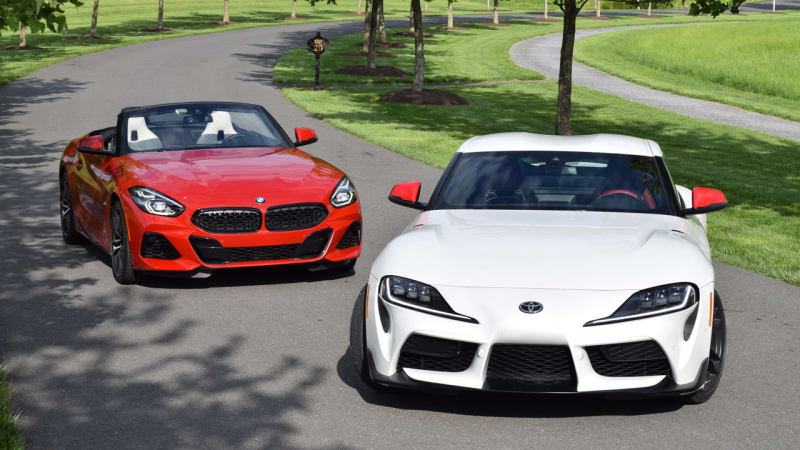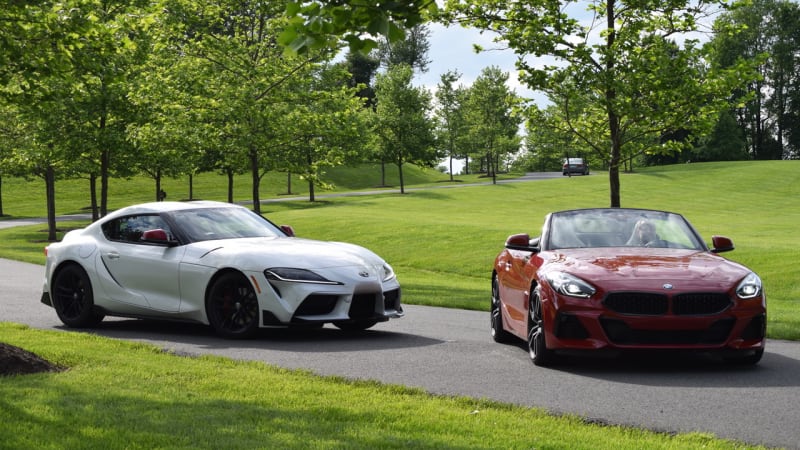The partnership that birthed the 2020 Supra coupe and BMW Z4 convertible makes the Bimmer the intriguing point-of-comparison, not a wholly unrelated Toyota that died more than 20 years ago. With all respect to the car’s loyal tuner crowd, Toyota’s job is to sell Supras, not to do fanservice to grown-up tuners or trade in nostalgia. Without BMW engineering and components, for which Toyota ponied up development cash, this Supra wouldn’t exist. Nor would the Z4.
That’s a win-win for anyone who’d like to see sports cars survive. As it happens, I’m almost assuredly the first auto journalist to have tested production versions of the Toyota and BMW back-to-back: I drove a Z4 down from New York for the Supra’s first media drive at Summit Point Motorsports Park in West Virginia.
For sports cars that share so many genes, they couldn’t feel more different. The rightness of BMW’s and Toyota’s strategy, developing these cars separately using the same mechanicals, practically blows my mind when I jump from the BMW into the Toyota and back again – and it should impress anyone who does the same. When compared to the soft-top BMW that feels richer and more grown-up with heftier responses, the hardtop Supra looks and acts like a frisky, tuner-friendly Toyota – a fact that will immediately divide many enthusiasts into one camp or the other. The easy cop-out would be to say that the Supra and Z4 are different cars for different buyers, and that’s true. But since I drove them both, forget cop-outs: Let’s tease out those differences.
Contents
Interior and exterior styling
In terms of styling Z4 leans conservative, an elegant evolution. The right color helps a lot. Meanwhile, the Toyota borrows what it can from the FT-1 concept that got Supra fans dreaming and drooling. But it’s a heavily redacted version of that vastly larger concept, and not entirely successful. The Supra looks like an eight-tenths-scale supercar from some angles, a tiny coupe that’s trying awfully hard to look imposing and exotic.
The Supra’s swollen hips are a prominent design cue, but they forced another compromise: Toyota couldn’t create the bulging form with a single steel stamping. So the two-piece fenders add yet another distracting cutline seam to a car that already has a surplus. The Supra is busy, yet youthful and provocative. But five years from now, the BMW will still be a BMW, and the Supra may not age as gracefully.
The Z4’s biggest advantage is its luxurious interior. Every touch point and technology is better: Soft fragrant leather on seats, the fat-gripped steering wheel and shifter, BMW’s dramatic, dual-screen Digital Cockpit and industry-leading head-up display. The Toyota’s driver-centric cockpit is effective in its own way, but uses a previous version of the iDrive interface with a different UI and physical buttons instead of the capacitive touch-operated ones. To me, it just doesn’t scream “$50,000 car”.
Powertrains and performance
In the interest of fairness, my particular Z4 was fighting with one hand and two cylinders behind its back: BMW calls it the Z4 sDrive 30i, but the confusing nameplate actually describes a 2.0-liter, turbocharged TwinPower four-cylinder with 255 horsepower and 295-pound feet of torque. Still, this is one of the world’s slickest, most overachieving four-bangers. It hustles this 3,287-pound convertible from 0-60 mph in a BMW-tested 5.2 seconds, mated to the same paddle-shifted, eight-speed ZF automatic transmission that does its hyper-efficient thing in the Supra. While Toyota wouldn’t confirm it, it seems a matter of time before America sees the more-affordable Supra with the same four-cylinder BMW engine offered in other markets. Budget-minded enthusiasts could perhaps expect a $43,000 base price.
The Toyota fires back a six-cylinder volley using BMW’s own ammunition: The familiar 3.0-liter inline-six with 335 horsepower and 365 pound-feet of torque, good for an estimated 4.1-second blast to 60 mph. And the Supra’s uniquely aggressive exhaust tuning produced raucous burps and backfires that echoed off Summit Point’s track walls, and the forested lanes of the Virginias.
BMW’s own one-upmanship comes via the Z4 M40i, whose 382 horses and 369 pound-feet – from the M Division’s heavily reworked version of the inline six – pips both the Supra and the 350-hp Porsche Boxster S. Pressed on why the Supra must make do with the less-powerful, slower-reacting version of the inline-six, Tada stresses the desire for Supra “balance.”

As for that shared ZF transmission, it’s pretty much impossible to screw up, and neither company has: Both the Toyota and BMW effortlessly blip through gears via their paddle shifters or in Drive modes. At Summit Point, I took to leaving the Supra in Drive, the better to concentrate on the tight and technical course, and the Toyota never once stumbled or got caught in the wrong gear.
Dynamics
Instead of benchmarking and competing against each other, Toyota and BMW looked to the biggest dynamic target in sports cars: the mid-engine Porsche 718 Cayman and Boxster. Almost inevitably, it seems, the Supra and Z4 don’t reach the Porsches’ Olympian heights of precision and pleasure. But I’ll promise you this: both the Toyota and BMW represent real sports-car achievement that’s not sullied by comparisons to those incomparable (and vastly pricier) Porsches.
Their virtual carbon-copy mechanicals are some blessing, including a chassis that Toyota says is more rigid than the Lexus LFA supercar, and the BMW-designed front MacPherson strut and rear-multi link suspension hardware. Team Supra was left to work its individual magic largely on tuning the electrically assisted steering, adaptive damping, transmission and electronic differential.
Both cars offer a range of driver-selectable settings via their rotary-knob iDrive controllers, including individualized settings for the steering, dampers, engine and transmission. Where the Toyota offers only Normal and Sport settings, BMW offers a wider spectrum, with an Eco mode and aggressive Sport Plus in addition to Comfort and Sport.
Ride and handling
The BMW’s steering is a clear performance edge. The Z4’s helm brings that signature German solidity and creamy sophistication that the Toyota can’t match. Listen, I prefer a light-steering sports car to one with artificial heaviness, but that’s not what’s happening here: The Toyota’s variable-assist and -ratio electric steering counts as a performance botch, period. That sensation was underlined by not only the BMW, but my street-and-track drive of the 2020 Toyota 86 TRD Special Edition, whose own fixed-ratio electric steering was spot-on firm compared with the Supra.
Weight is another mild disappointment; the Supra checks in at 3,397 pounds, 110 more than BMW’s four-cylinder convertible. In six-cylinder guise, the BMW weighs 3,443 pounds, just 46 more than Toyota’s coupe. Those caveats aside, the Supra is chock full of personality, and a blast to drive, though both sports cars could transmit more feedback from their front wheels.
With its wide stance, 50:50 weight balance and a lower center-of-gravity than the Toyota 86, the Supra is as tossable as a soggy tennis ball to a Golden Retriever. Like that ball, the Supra’s quite happy to spin. As a caveat, I drove the BMW and Toyota back-to-back on public roads here, but couldn’t (this being a Toyota event) lap the Z4 at Summit Point, though I recently tested the Z4 on track in California. The BMW can also be coaxed into lurid slides, but it prefers a steadier hand and a more precise line.
Not surprisingly, the luxurious BMW also shows a bit more bump isolation and suspension compliance. Chuck the Supra hard into a hot corner, and instead of understeering, it will slide with a dead-neutral attitude. Come in with a more-controlled entry speed, get back to throttle early on exit, and you can still churn the rear tires and execute a stylish drift. Michelin Pilot Super Sport summer tires deliver just-right amount of grip without sacrificing too much tread life for everyday use.
As Toyota engineers intended, it takes idiocy or obliviousness to produce snap oversteer or a spin. In that vein, the Supra advances the trend of all modern sports cars and supercars: It’s fun and approachable for the amateur, but not dumbed-down for an expert or even professional driver. Brembo brakes, including four-piston calipers and 13.7-inch ventilated rotors up front, were up to the all-day task at Summit Point. And the engine is a joy, despite giving up 47 horsepower to BMW’s six-cylinder version. In modern BMW fashion, it barely feels like a turbocharged engine (aside from its low-range torque), with minimal lag and a torrent of linear thrust right up to redline.

The Supra, Z4, and the competition
It’s natural and unavoidable to compare two sports cars that have so much in common, despite very different audiences: The typical BMW shopper seems unlikely to cross-shop a Toyota coupe. As such, for the Z4, the real rivals are the Porsche 718 Boxster, Audi TT and Mercedes SLC convertibles. The Supra, on paper, also stacks up to the 718 Cayman and TT coupe, and if you’re OK dropping $50,000 on a Toyota, doing so on a Porsche or Audi shouldn’t be a problem either. That said, among non-luxury makers, there’s really nothing apart from the arthritic and out-gunned Nissan 370Z and the American muscle cars that are literally and figuratively in a different weight class.
Interestingly, the six-cylinder Toyota Supra is priced much like the four-cylinder Z4 (50,920, versus $50,695, respectively). That’s big money for a Toyota, but it’s fair for a modern sports car built on Bavarian bones. Start adding pricey BMW options, and that fairness becomes clearer. Where the 335-hp Supra 3.0 Premium comes virtually loaded at $54,920, my 255-hp Z4 sDrive 30i cost $63,845 with a slew of options. As for the 382-hp Z4 M40i, its $65,690 base price is nearly $16,000 above the Supra’s, though still about $7,000 below a 718 Boxster S. Again, that’s before the first BMW option is tallied; you’re realistically looking at a roughly $73,000 roadster.
















